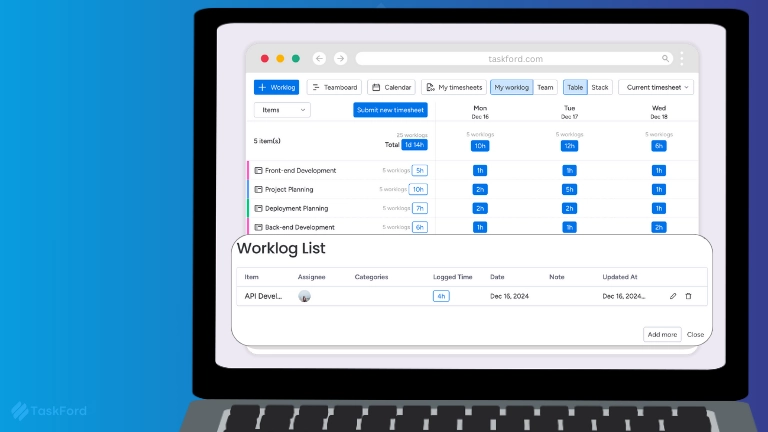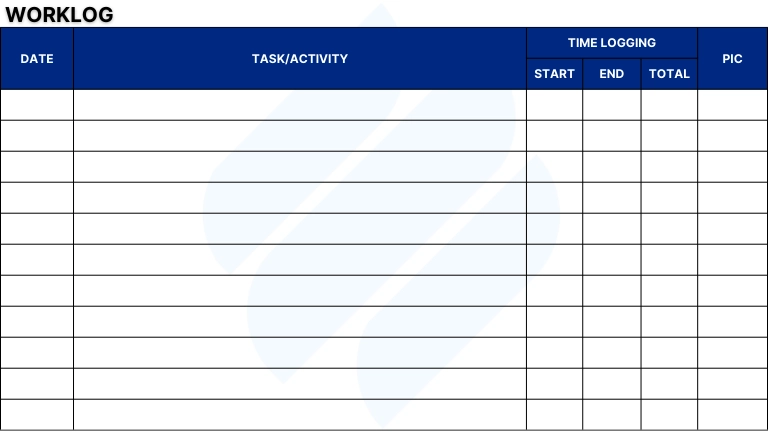How to Boost Work Efficiency with a Worklog System
Boost work efficiency with a worklog system! Learn to track tasks, manage time, and analyze productivity for better performance. Get practical tips to streamline workflows today!
In today’s fast-paced professional landscape, boosting efficiency is a critical goal for individuals and teams alike. One proven method to achieve this is by implementing a worklog—a powerful tool for tracking tasks, managing time, and analyzing productivity patterns. A well-maintained worklog provides a structured framework that empowers professionals to take control of their workday, ensuring that every minute is spent purposefully.
This article dives deep into how a worklog can elevate work efficiency, offers detailed strategies for maintaining one. We’ll also address challenges and provide actionable solutions to make your worklog a cornerstone of success.
 Key Takeaways
Key Takeaways
- Improves Time Management: A worklog tracks time allocation, enabling better prioritization and time management.
- Enhances Productivity: Offers structure and accountability to minimize wasted effort through effective task management.
- Enables Progress Tracking: Monitors milestones and patterns with tools like timesheets and advanced roadmaps.
- Supports Better Decision-Making: Provides data-driven insights for resource planning and cost management.
Understanding the Concept of a Worklog
A worklog is more than just a to-do list—it’s a comprehensive record of work activities, including tasks completed, time spent, and challenges faced. Think of it as a professional journal that captures your daily workflow in detail. By maintaining a worklog, you gain visibility into how you spend your time, allowing for smarter time tracking and adjustments to improve efficiency. For instance, a software developer might use a worklog to document coding hours, bug fixes, and testing phases, while a marketing manager might track campaign planning and content creation.
Businesses benefit from worklogs too. Managers can leverage them for project planning and resource management, ensuring teams are aligned and resources are allocated effectively. Whether you’re an individual contributor or leading a team, a worklog is a foundational tool for portfolio management, helping you oversee multiple projects with clarity.

Benefits of Maintaining a Worklog
1. Improved Time Management
Keeping a worklog helps employees track how much time they spend on various tasks. By analyzing these logs, individuals can identify time-consuming activities and find ways to complete them more efficiently. For example, if an employee realizes they spend too much time on emails, they can set specific time blocks for email management to minimize distractions.
2. Enhanced Productivity
With a worklog, you can structure your day around high-impact tasks, reducing distractions. This aligns with task management principles, ensuring accountability and focus. Imagine a graphic designer logging hours on client revisions versus brainstorming— the worklog highlights where effort yields the most value.
3. Clear Progress Tracking
Worklogs act as a timeline of achievements, ideal for long-term projects. By integrating timesheet, you can monitor milestones and spot delays early. For complex initiatives, an advanced roadmap within your worklog system can visualize progress across phases.
4. Better Communication and Collaboration
Shared worklogs enhance team transparency. Team members can review logs for resource planning, ensuring balanced workloads and avoiding duplicated efforts. This fosters collaboration, a key aspect of project management.
5. Increased Accountability
A worklog holds you accountable by documenting your efforts. For teams, it ensures tasks are completed on schedule, supporting budget management by preventing overruns due to procrastination or mismanagement.
6. Effective Decision-Making
Managers can analyze worklog data for cost management and resource management. For example, if a worklog shows a team member consistently over-allocated, adjustments can be made to optimize performance and reduce burnout.
Implementing an Effective Worklog System

To harness these benefits, you need a robust worklog system. Here’s how to set one up:
-
Choose the Right Format
- Digital Tools: Platforms like TaskFord, Trello, or Asana offer seamless time tracking and task management. TaskFord, for instance, provides advanced roadmaps for project planning.
- Spreadsheets: Google Sheets can track tasks and time with custom timesheet.
- Notebooks: Handwritten worklogs suit those who prefer simplicity. Select a format that aligns with your project management needs and team size.
-
Define Key Categories
Structure your worklog with:
- Date/Time: Log entries with timestamps.
- Task Descriptions: Detail what you worked on.
- Time Spent: Record duration for time management.
- Challenges: Note obstacles for future resource planning.
- Notes: Add insights or follow-ups. This structure supports portfolio management by keeping data organized.
-
Maintain Consistency
Update your worklog daily—ideally after each task or at day’s end. Consistency ensures accuracy, which is vital for time tracking and budget management. Set reminders if needed.
-
Set Clear Objectives
Start each day with goals in your worklog. Compare these to completed tasks to gauge efficiency, refining your task management approach over time.
-
Periodic Review and Analysis
Review your worklog weekly or monthly to spot trends. Use insights for resource management and to celebrate wins. Tools like TaskFord offer dashboards for this purpose.
Overcoming Challenges in Maintaining a Worklog
While worklogs offer significant benefits, they can also present challenges. Here are some common issues and strategies to overcome them:
1. Consistency Issues
Many individuals struggle with maintaining a worklog consistently, especially during busy periods. Setting reminders or integrating worklogging into the daily routine can help develop consistency and better time tracking result.
2. Time Constraints
Some professionals may find it time-consuming to document their work regularly. To address this, using simple, structured templates or digital tools that automate time tracking can streamline the process.
3. Accuracy Concerns
Delaying worklog entries can lead to forgotten details and inaccurate records. Logging tasks immediately after completion or using voice-to-text features can help capture accurate information efficiently for time management.
4. Resistance to Change
Some employees may resist using a worklog due to perceived micromanagement. Educating teams on the benefits of worklogs and how they improve project planning, cost management and efficiency can encourage adoption.
Best Practices for Sustaining a Worklog
To make your worklog a lasting habit, follow these tips:
- Keep It Simple: Focus on key details to avoid overwhelm.
- Use Automation: Tools like TaskFord automate time tracking and resource planning.
- Make It a Habit: Log at set times daily.
- Review Regularly: Analyze data for portfolio management insights.
- Encourage Team Adoption: Promote worklogs for project management and collaboration.
Expanding Your Worklog’s Potential
A worklog’s value grows with integration into broader systems. For example:
- Project Management: Link worklogs to advanced roadmap for a holistic view.
- Budget Management: Track time against costs to stay within limits.
- Resource Management: Use worklog data to allocate team members effectively.
- Portfolio Management: Oversee multiple projects with aggregated worklog insights.
Consider a scenario: A project manager uses a worklog to track a product launch. By logging tasks like design, development, and marketing, they identify bottlenecks (e.g., prolonged design revisions). With TaskFord, they adjust resource planning, reallocating staff to meet deadlines while keeping costs in check via cost management.
Tools to Enhance Your Worklog

Leveraging technology can supercharge your worklog:
- TaskFord: Offers advanced roadmap, timesheet, and time tracking for seamless project planning. Join our waitlist for TaskFord to experience it firsthand
- Asana: Great for task management and team collaboration.
- Microsoft Excel: Customizable for budget management and resource planning.
- Others: DeskTime, Toggl Track, Clockify, ClickUp, etc.
Conclusion
A worklog is a game-changer for work efficiency. By systematically tracking tasks, time, and challenges, you unlock insights that drive task management, time tracking, and project management. Overcoming initial hurdles with consistency and the right tools—like TaskFord—transforms your worklog into a powerhouse of productivity. Whether you’re refining personal workflows or leading a team, a worklog supports budget management, resource planning, and portfolio management, ensuring success across projects.
Ready to take your efficiency to the next level? Join our waitlist now for TaskFord and discover how a cutting-edge worklog system can revolutionize your workday!
Making work simpler,
smarter, and more connected
Join our waitlist and be notified first.

Subscribe for Expert Tips
Unlock expert insights and stay ahead with TaskFord. Sign up now to receive valuable tips, strategies, and updates directly in your inbox.



